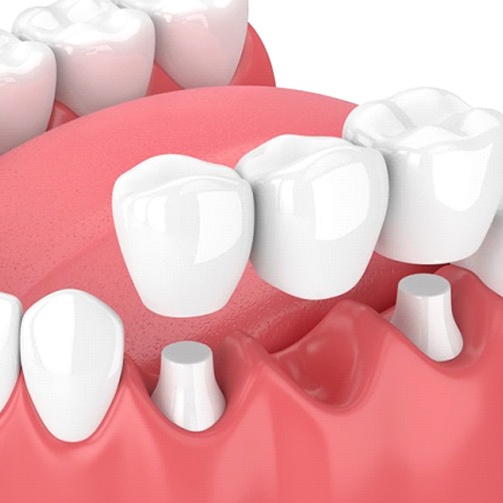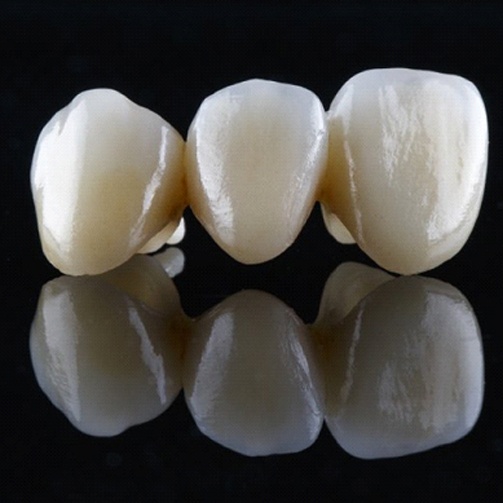Dental Bridges Idaho Falls
Fill the Gaps in Your Smile Today!

With the right at-home care and regular dental checkups, your teeth can last a lifetime. Unfortunately, complications can arise despite our best efforts, and sometimes we have to get teeth removed. Missing teeth come with a whole host of problems, from not being able to chew certain foods to losing confidence in your smile. The good news is that you don’t have to live like this forever. At Cline Family & Cosmetic Dentistry, we can literally bridge the gaps in your smile with dental bridges in Idaho Falls. With this solution that looks and feels perfectly natural, you can eat and grin with confidence again. Contact us today to learn more.
Why Choose Cline Family & Cosmetic Dentistry for Dental Bridges?
- Replace Multiple Consecutive Teeth
- Dentist with Years of Experience and Training
- High-Quality, Custom-Made Restorations
What Are Dental Bridges?

A dental bridge is one of the most traditional ways to replace the portions of one or more missing teeth above the gumline. By taking impressions of your mouth, customized dental crowns are made and placed on the remaining teeth at either end of the gap in your smile. These teeth are known as abutment teeth. Then, anywhere from one to three artificial teeth (called pontics) are suspended in between them, replacing several missing teeth in one fell swoop.
For a more modern solution, a dental bridge can also be anchored onto dental implants in Idaho Falls. One of these titanium posts can be placed at either end of the space in your grin. The crowns sit atop them and support the pontics. Bridges that are supported by dental implants are typically sturdier and last several years longer than traditional ones.
The Process of Getting a Dental Bridge

After a consultation with Dr. Brent Cline to determine that you’re a good candidate for a dental bridge, we can begin the treatment process.
During the first of a couple of appointments, we reshape your abutment teeth so that there is enough room in your mouth for the restoration. Once your teeth are prepared, we take impressions of that area of your mouth. These impressions are sent to a dental lab, where it can take a few weeks to design your bridge. In the meantime, we might place a temporary bridge. Once your final restoration is ready, simply return to our office to have your permanent bridge placed.
If you opt for an implant-retained bridge, you’ll have to undergo an oral surgery to have the implants placed and then wait a few months for the posts to integrate with your jawbone. While the process takes longer, many patients find that the added security that dental implants provide is well worth the wait.
Benefits of Dental Bridges

Some of the advantages of dental bridges are:
- They prevent surrounding teeth from trying to fill the gap by drifting out of place.
- Each bridge is customized and made from high-quality, natural-looking materials to blend in with the rest of your smile.
- Bridges are strong enough to allow you to chew practically any food.
- With excellent oral hygiene and regular dental checkups, a bridge can last more than 10 years before it needs a replacement.
Dental Bridges FAQs
Can You Take a Dental Bridge Out?
Dental bridges are designed to be a long-term solution for tooth loss, meant to remain in place for years after being put in place. This requires the use of an industrial grade dental adhesive to secure the dental bridge into position.
All this is to say that dental bridges cannot be taken out except by a professional. Once we replace your teeth with one, they should stay there for a decade or two without moving in the slightest.
Partial dentures can be taken out and are sometimes referred to as a “removable bridge” for this reason. However, this is a bit of a misnomer—this is an entirely separate method of tooth replacement.
Is Getting a Dental Bridge Painful?
Putting your dental bridge in place will require removing a small portion of your enamel. However, there’s no reason to be worried about discomfort associated with the procedure; we will numb your mouth before beginning the placement of your dental bridge, which means that you’ll be completely comfortable throughout the process.
Many patients are a bit sore in the days after their dental bridge placement, but this should be easily ameliorated by taking over-the-counter pain relievers. If the discomfort gets worse instead of better, give us a call—it could be a sign that there’s an issue with your dental bridge placement.
How Long Should a Dental Bridge Last?
Dental bridges can generally last somewhere between five and fifteen years, with the exact lifespan of your restoration being affected by several factors. Some of these are out of your control—for example dental bridges on the molars are put under more pressure and are therefore likely to fail sooner.
However, the most important factor is your personal dental hygiene. If you brush twice a day, floss daily, and use mouthwash frequently you can keep your teeth and gums healthy, ensuring the durability of your restoration. You can also do what you can to avoid bad habits that can damage your restoration, like smoking, nail biting, or chewing on ice.
How Many Teeth Can a Dental Bridge Replace?
Dental bridges are designed to replace anywhere from one to four consecutive teeth—however, they’re ideal for replacing only one or two. The longer your dental bridge is, the more pressure you’ll put on the center of it—just like a real bridge! That means that the more teeth you aim to replace with the bridge, the sooner it’s likely to fail.
A longer dental bridge can also be difficult if the natural teeth supporting it have problems with disease or decay. Of course, implant dentures make this less of an issue.
I Need a Checkup & Cleaning I am Looking for a Dentist for My Child I am Concerned About Bleeding Gums I Have a Cavity or Broken Tooth I am Missing One or More Teeth I am Unhappy with My Smile I Want a Straighter Smile I am Scared of the Dentist I am in Pain & Need Help I Need My Wisdom Teeth Removed View Our Services

